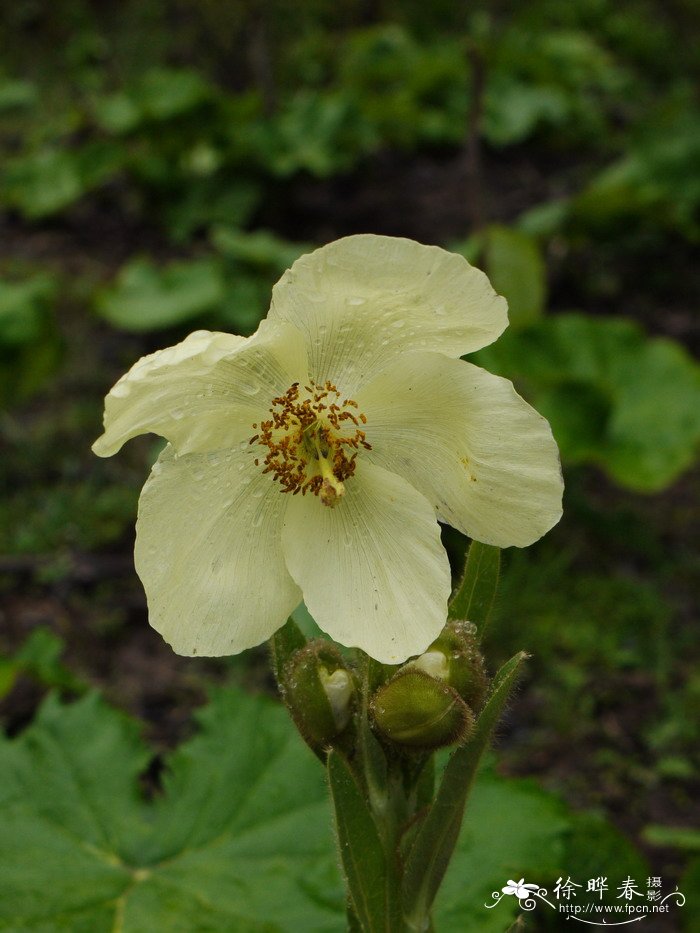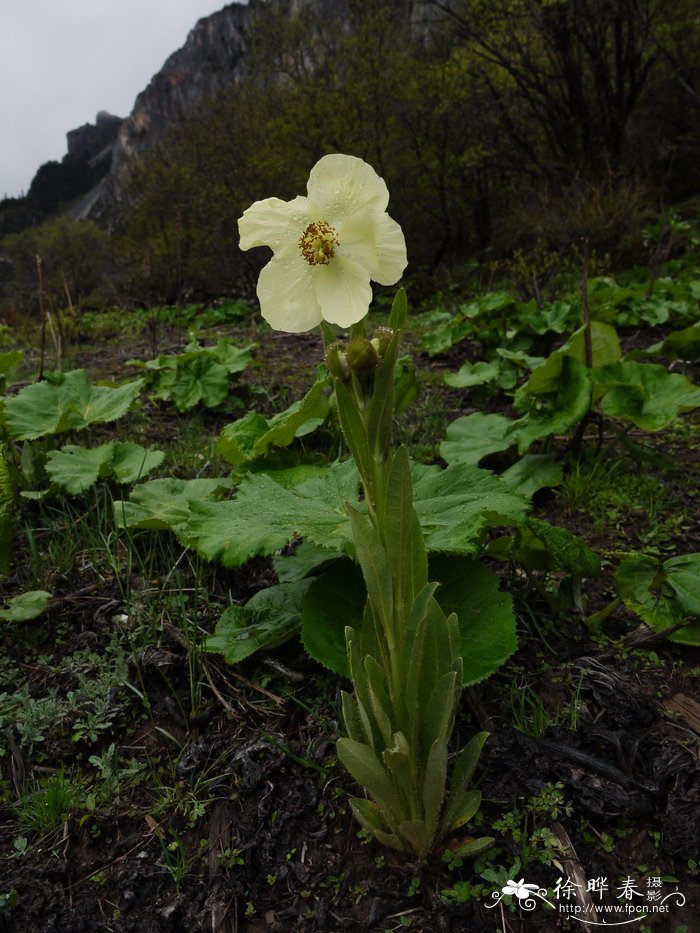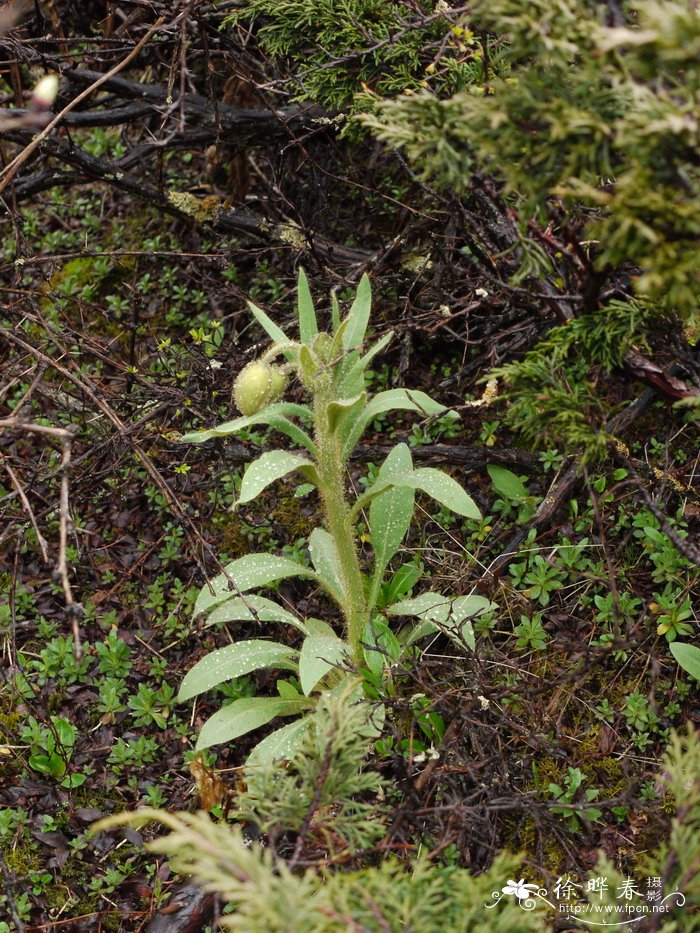全缘叶绿绒蒿Meconopsis integrifolia
中文名(Chinese Name):全缘叶绿绒蒿
学名(Scientific Name):Meconopsis integrifolia (Maxim.) Franch.
英文名(English Common Name):
别名(Chinese Common Name):黄芙蓉、横断山绿绒蒿
异名(Synonym):Meconopsis pseudointegrifolia Prain Meconopsis integrifolia var. souliei Fedde Meconopsis brevistyla Kingdon-Ward Cathcartia integrifolia Maxim. Meconopsis pseudointegrifolia subsp. robusta Grey-Wilson
科属(Family & Genus):罂粟科(Papaveraceae)绿绒蒿属
形态特征(Description):一年生至多年生草本,全体被锈色和金黄色平展或反曲、具多短分枝的长柔毛。主根粗约1厘米,向下渐狭,具侧根和纤维状细根。茎粗壮,高达150厘米,粗达2厘米,不分枝,具纵条纹,幼时被毛,老时近无毛,基部盖以宿存的叶基,叶基密被具多短分枝的长柔毛。基生叶莲座状,其间常混生鳞片状叶,叶片倒披针形、倒卵形或近匙形,连叶柄长8-32厘米,宽1-5厘米,先端圆或锐尖,基部渐狭并下延成翅,至叶柄近基部又逐渐扩大,两面被毛,边缘全缘且毛较密,通常具3至多条纵脉并在翅上延伸;茎生叶下部者同基生叶,上部者近无柄,狭椭圆形、披针形、倒披针形或条形,比下部叶小,最上部茎生叶常成假轮生状,狭披针形、倒狭披针形或条形,长5-11厘米,宽0.5-1厘米。花通常4-5朵,稀达18朵,生最上部茎生叶腋内,有时也生于下部茎生叶腋内;花梗长(3-)6-37(-52)厘米,果时延长。花芽宽卵形;萼片舟状,长约3厘米,外面被毛,里面无毛,具数十条明显的纵脉;花瓣6-8,近圆形至倒卵形,长3-7厘米,宽3-5厘米,黄色或稀白色,干时具褐色纵条纹;花丝线形,长0.5-1.5厘米,金黄色或成熟时为褐色,花药卵形至长圆形,长1-2(-4)毫米,橘红色,后为黄色至黑色;子房宽椭圆状长圆形、卵形或椭圆形,密被金黄色、紧贴、通常具多短分枝的长硬毛,花柱极短至长1.3厘米,无毛,柱头头状,4-9裂下延至花柱上,略辐射于子房顶。蒴果宽椭圆状长圆形至椭圆形,长2-3厘米,粗1-1.2厘米,疏或密被金黄色或褐色、平展或紧贴、具多短分枝的长硬毛,4-9瓣自顶端开裂至全长1/3。种子近肾形,长1-1.5毫米,宽约0.5毫米,种皮具明显的纵条纹及蜂窝状孔穴。花果期5-11月。
分布(Distribution):产甘肃、青海、四川、云南、西藏,生于海拔2700-5100米的草坡或林下。缅甸东北部有分布。
用途(Use):全草清热止咳;花前采叶入药,治胃中反酸;花退热催吐、消炎,治跌打骨折。
引自中国植物志英文版:FOC Vol. 7 Page 263, 267, 268
Meconopsis integrifolia (Maximowicz) Franchet, Bull. Soc. Bot. France. 33: 389. 1886.
全缘叶绿绒蒿 quan yuan ye lü rong hao | Papaveraceae | Meconopsis
Herbs, monocarpic, to 1 m tall in flower, throughout with long barbellate hairs, underlain with often dense, long, rufous or golden, barbellate hairs. Stem erect, to 2 cm in diam. near base, simple, longitudinally striate, pilose when young but nearly glabrous when old, base with persistent leaf bases densely shortly branched villous. Basal leaves in a deciduous rosette, among often mixed scalelike leaves; blade oblanceolate, obovate, elliptic, or nearly spatulate, 8-37 (including petiole) × 1-5 cm, both surfaces pilose, usually with 3(-5) or more longitudinal veins, base attenuate, not decurrent into petiole, margin entire and densely pilose, apex rounded or acute. Lower cauline leaves similar to basal leaves but gradually smaller; upper ones almost sessile, narrowly elliptic, lanceolate, oblanceolate, or linear-lanceolate, smaller than lower ones; uppermost leaves bractlike, forming a whorl beneath flowers, narrowly lanceolate or narrowly oblanceolate to linear, 5-11 × 0.5-1 cm. Flowers usually 3-5, rarely to 10-flowered, to 20 cm in diam., erect to suberect at maturity, arising from axils of uppermost leaves, occasionally with a few smaller flowers alternatively from stem below whorl of leaves. Pedicel (3-)6-37(-52 in fruit) cm. Flower buds broadly ovoid, spreading hairy. Sepals cymbiform, ca. 3 cm, abaxially pilose, glabrous within, with many distinct longitudinal veins. Petals 6-8, mid- to deep yellow, suborbicular to obovate, 4-9.5 × 3-5 cm, often markedly incurved. Filaments of same color as petals, golden brown at maturity, filiform; anthers yellow or yellowish brown, ovoid to oblong, 1-2(-4) mm. Ovary broadly elliptic-oblong or ovoid to narrowly ellipsoidal, densely appressed golden hirsute; styles obsolete or very short to 4 mm, glabrous; stigmas capitate, 4-7-lobed, decurrent and slightly actinomorphic at apex of ovary. Capsule broadly elliptic or oblong to elliptic, 2-3 × 1-1.2 cm, ascending to appressed golden or brown hirsute, 4-7-valvate for 1/3 distance from apex. Fl. May-Aug.
Grassy and rocky slopes, forest understories, open shrublands, mountain moorlands, stabilized moraines; 2700-5100 m. SW Gansu, E and S Qinghai, W Sichuan, E and S Xizang, NE and NW Yunnan [NE Myanmar].


 (责任编辑:徐晔春)
(责任编辑:徐晔春)
学名(Scientific Name):Meconopsis integrifolia (Maxim.) Franch.
英文名(English Common Name):
别名(Chinese Common Name):黄芙蓉、横断山绿绒蒿
异名(Synonym):Meconopsis pseudointegrifolia Prain Meconopsis integrifolia var. souliei Fedde Meconopsis brevistyla Kingdon-Ward Cathcartia integrifolia Maxim. Meconopsis pseudointegrifolia subsp. robusta Grey-Wilson
科属(Family & Genus):罂粟科(Papaveraceae)绿绒蒿属
形态特征(Description):一年生至多年生草本,全体被锈色和金黄色平展或反曲、具多短分枝的长柔毛。主根粗约1厘米,向下渐狭,具侧根和纤维状细根。茎粗壮,高达150厘米,粗达2厘米,不分枝,具纵条纹,幼时被毛,老时近无毛,基部盖以宿存的叶基,叶基密被具多短分枝的长柔毛。基生叶莲座状,其间常混生鳞片状叶,叶片倒披针形、倒卵形或近匙形,连叶柄长8-32厘米,宽1-5厘米,先端圆或锐尖,基部渐狭并下延成翅,至叶柄近基部又逐渐扩大,两面被毛,边缘全缘且毛较密,通常具3至多条纵脉并在翅上延伸;茎生叶下部者同基生叶,上部者近无柄,狭椭圆形、披针形、倒披针形或条形,比下部叶小,最上部茎生叶常成假轮生状,狭披针形、倒狭披针形或条形,长5-11厘米,宽0.5-1厘米。花通常4-5朵,稀达18朵,生最上部茎生叶腋内,有时也生于下部茎生叶腋内;花梗长(3-)6-37(-52)厘米,果时延长。花芽宽卵形;萼片舟状,长约3厘米,外面被毛,里面无毛,具数十条明显的纵脉;花瓣6-8,近圆形至倒卵形,长3-7厘米,宽3-5厘米,黄色或稀白色,干时具褐色纵条纹;花丝线形,长0.5-1.5厘米,金黄色或成熟时为褐色,花药卵形至长圆形,长1-2(-4)毫米,橘红色,后为黄色至黑色;子房宽椭圆状长圆形、卵形或椭圆形,密被金黄色、紧贴、通常具多短分枝的长硬毛,花柱极短至长1.3厘米,无毛,柱头头状,4-9裂下延至花柱上,略辐射于子房顶。蒴果宽椭圆状长圆形至椭圆形,长2-3厘米,粗1-1.2厘米,疏或密被金黄色或褐色、平展或紧贴、具多短分枝的长硬毛,4-9瓣自顶端开裂至全长1/3。种子近肾形,长1-1.5毫米,宽约0.5毫米,种皮具明显的纵条纹及蜂窝状孔穴。花果期5-11月。
分布(Distribution):产甘肃、青海、四川、云南、西藏,生于海拔2700-5100米的草坡或林下。缅甸东北部有分布。
用途(Use):全草清热止咳;花前采叶入药,治胃中反酸;花退热催吐、消炎,治跌打骨折。
引自中国植物志英文版:FOC Vol. 7 Page 263, 267, 268
Meconopsis integrifolia (Maximowicz) Franchet, Bull. Soc. Bot. France. 33: 389. 1886.
全缘叶绿绒蒿 quan yuan ye lü rong hao | Papaveraceae | Meconopsis
Herbs, monocarpic, to 1 m tall in flower, throughout with long barbellate hairs, underlain with often dense, long, rufous or golden, barbellate hairs. Stem erect, to 2 cm in diam. near base, simple, longitudinally striate, pilose when young but nearly glabrous when old, base with persistent leaf bases densely shortly branched villous. Basal leaves in a deciduous rosette, among often mixed scalelike leaves; blade oblanceolate, obovate, elliptic, or nearly spatulate, 8-37 (including petiole) × 1-5 cm, both surfaces pilose, usually with 3(-5) or more longitudinal veins, base attenuate, not decurrent into petiole, margin entire and densely pilose, apex rounded or acute. Lower cauline leaves similar to basal leaves but gradually smaller; upper ones almost sessile, narrowly elliptic, lanceolate, oblanceolate, or linear-lanceolate, smaller than lower ones; uppermost leaves bractlike, forming a whorl beneath flowers, narrowly lanceolate or narrowly oblanceolate to linear, 5-11 × 0.5-1 cm. Flowers usually 3-5, rarely to 10-flowered, to 20 cm in diam., erect to suberect at maturity, arising from axils of uppermost leaves, occasionally with a few smaller flowers alternatively from stem below whorl of leaves. Pedicel (3-)6-37(-52 in fruit) cm. Flower buds broadly ovoid, spreading hairy. Sepals cymbiform, ca. 3 cm, abaxially pilose, glabrous within, with many distinct longitudinal veins. Petals 6-8, mid- to deep yellow, suborbicular to obovate, 4-9.5 × 3-5 cm, often markedly incurved. Filaments of same color as petals, golden brown at maturity, filiform; anthers yellow or yellowish brown, ovoid to oblong, 1-2(-4) mm. Ovary broadly elliptic-oblong or ovoid to narrowly ellipsoidal, densely appressed golden hirsute; styles obsolete or very short to 4 mm, glabrous; stigmas capitate, 4-7-lobed, decurrent and slightly actinomorphic at apex of ovary. Capsule broadly elliptic or oblong to elliptic, 2-3 × 1-1.2 cm, ascending to appressed golden or brown hirsute, 4-7-valvate for 1/3 distance from apex. Fl. May-Aug.
Grassy and rocky slopes, forest understories, open shrublands, mountain moorlands, stabilized moraines; 2700-5100 m. SW Gansu, E and S Qinghai, W Sichuan, E and S Xizang, NE and NW Yunnan [NE Myanmar].
踩一下[0]

顶一下[2]